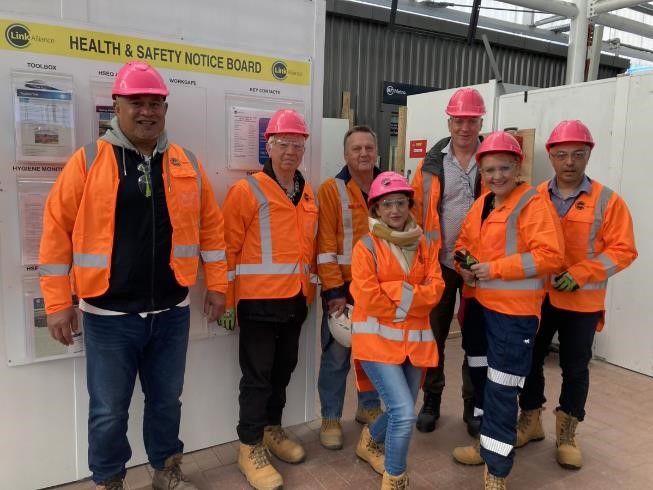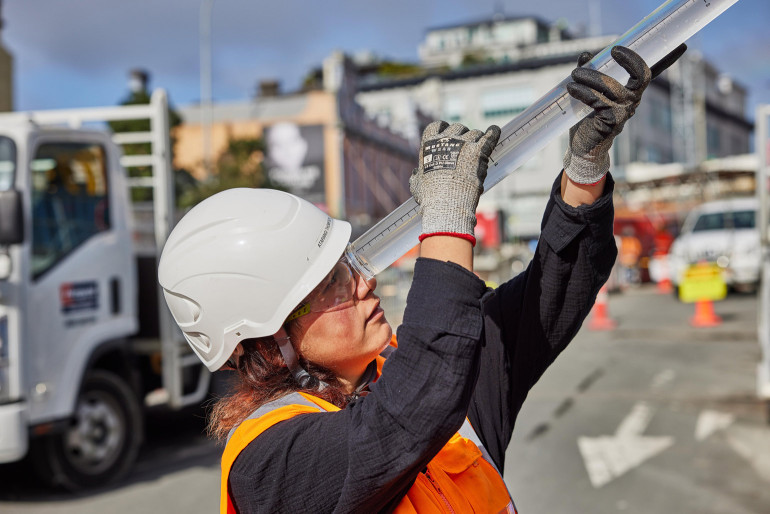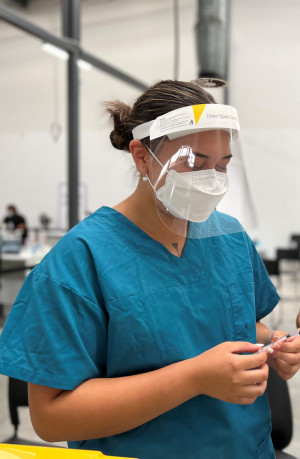Our economy, industry and business highlights
Hāpaita te ara tika pūmau ai te rangatiratanga mō ngā uri whakatipu
Foster the pathway of knowledge to strength, independence and growth for future generations
On this page

Members of RSLG and MBIE visit the City Rail Link project
Construction
Recent investment in large 5–20-year construction and infrastructure projects has made this sector a regional priority.
However, there are still major people and skill gaps. The RSLG has committed to advocating for construction and infrastructure training to be effectively delivered and tailored to the future regional needs.
To achieve this, an intergenerational approach will be required to develop the pipeline of education and training, and to create opportunities for sustainable, long-term, skilled employment for the local workforce.
Large projects in Tāmaki Makaurau
Auckland Harbour bridge Crossing
The multi-billion-dollar construction of a second Waitematā crossing commencing in 2029 is set to address persistent congestion in Tāmaki Makaurau. While a number of jobs will be filled by local workers, experts have noted that the project will require specialist skillsets. Based on current supply, recruitment of skilled migrant workers will be required to meet project needs.
Auckland Airport
Auckland Airport is set to open its multi-billion-dollar terminal integration redevelopment in 2028-2029, which will create 2,000 additional jobs at the height of construction. Additionally, the RSLG is engaged with Ara, the airport jobs and skills hub, which is supporting South Auckland workers to transition into employment and build skills through apprenticeships.
Auckland Light Rail
The Auckland Light Rail project is the future expansion of Auckland’s mass transit system. The costs are estimated to be $14 billion over the delivery of the project. The bulk of workforce demand will be in general labour, followed by management level skills to oversee a mechanical, engineering, rail works, plumbing, fire systems, station controls, lifts and escalators, tunnelling, testing and commissions, and finishing trades workforce.
City Rail Link (CRL)
CRL is the largest transport infrastructure project ever to be undertaken in New Zealand. It will better connect Auckland’s entire rail network and double its capacity through construction of a new underground metro, two new inner-city train stations and redeveloping 2 existing stations. Construction is due to finish
in November 2025 with an estimated cost of $5.49 billion – creating thousands of jobs and procurement opportunities. CRL’s main works are being delivered by Link Alliance which has inducted over 9,000 people onto the project since 2019 and currently has a team of over 2,000.
Over the last year, the RSLG engaged with Waihanga Ara Rau and industry stakeholders to better understand and support workforce participation, skills transition, improved workplace learning experiences. These engagements have helped the RSLG to understand what good looks like, in terms of effective recruitment, as well as delivery of training and skills development programmes tailored to future regional needs. One example of this is with the Link Alliance who run CRL’s Progressive Employment Programme (PEP). PEP is an industry-led, tailored training programme committed to supporting the pipeline of young talent into the industry and creating opportunities for sustainable, long-term, skilled employment for the local workforce.
CRL case study

Atarangi started with the CRL project in 2019 as one of 6 pioneers on the Progressive Employment Programme (PEP). At that time, she was living in Pukekohe and had to catch the 5.15am train to Papakura and then to Waitematā (Britomart) to arrive just in time to start work at 7am.
After graduating from the PEP, Atarangi was employed by Downers and seconded to the Link Alliance. She started as a member of the Procurement team and spent a year learning the foundations of procurement. Atarangi then mentored and trained another young PEP intern to take over her role, enabling her to transition into the Environmental and Sustainability team.
Atarangi has been providing support at the Karanga-a-Hape and Te Waihorotiu work sites for two years and in July of 2022 enrolled in a Bachelor of Environmental Science. She is completing 2 papers a semester while maintaining excellent standards in her full-time role as an Environmental Assistant.
Hospitality
“Chefs, chefs, chefs! Virtually impossible to find anyone. We’ve given up on trying to find chefs and have accepted that we’ll have to think outside the square with kitchen staff. Really hard to find anyone who is trained.”
Auckland Restaurant Owner, February 2023 Restaurant Association of New Zealand member survey.
Auckland’s hospitality sector has expressed concerns regarding the labour shortage in the sector, particularly for trained chefs. Stakeholders have shared their struggles to recruit and retain sufficient workers in a tight labour market, citing significant increases in wages and competition. This is reflected in data from the Restaurant Association of New Zealand workforce dashboard (February 2023):
- 82% of respondents say they are not fully staffed.
- 78% have been recruiting for high level roles over the past 2 months.
- 88% of employers are saying it is difficult or extremely difficult to recruit for senior roles.
The RSLG has worked closely with the Restaurant Association New Zealand to support the implementation of Future of Hospitality Roadmap goals. One outcome of this mahi is the launch of the HospoCred program. HospoCred is an industry-led accreditation developed to improve working conditions, to recognise and maintain best practice and good business; and signals outstanding hospitality employers to government, employees, consumers and other businesses. Over the past year, 230 businesses have signed up to the programme. The RSLG is pleased to see HospoCred is now included in the Tourism Better Work Action Plan, and accredited businesses are recognised and automatically included in the Tourism and Hospitality Accord. A second outcome of the Roadmap goals has been the launch of the hospitality industry Rangatahi Project/Youth Council. The RSLG has engaged closely with Restaurant Association who, with Ringa Hora (Services Workforce Development Council) are kicking off this industry-led initiative. It is aimed at engaging youth to help shape strategy that addresses the skills shortages. The focus is on training and skills pipelines for the industry, raising the sector’s attractiveness, and promoting sustainable career pathways and other key areas for the industry.
Impacts of January-February 2023 adverse weather events on the industry
The cumulative effects of the adverse weather events and COVID-19 restrictions cannot be overlooked. Pockets of the hospitality industry located in the coastal areas and Auckland’s CBD continue to experience hardship. While many businesses sustained minor damage and were quickly able to re-open, others in the industry are facing a long journey to recovery.
Marisa Bidois, RSLG member and CEO of Restaurant Association of New Zealand (RANZ) along with her team sourced feedback from their Restaurant Association members to gauge the ‘Impact of Cyclone Gabrielle’ in Auckland (February 2023):
“After 2 years of COVID, this is the nail in the coffin. We are a seasonal business needing to make money in summer to survive winter, but we are way down.”
- Business owner, RANZ member
“This is far more devastating than COVID. At least there was financial assistance and wage subsidies straight away. Right now, I do not know how to pay [staff]. Money is going out, but nothing is coming in.”
- Business owner, RANZ member
Following the adverse weather events, Restaurant Association NZ ran a cyclone relief fundraising campaign ‘Cooking up a Storm’ with Chef Al Brown and over 150 restaurants around the country. This initiative raised $400,000. Proceeds were divided amongst the Mayoral Relief Funds and $130,000 was paid out to impacted hospitality businesses.
Supporting the future healthcare workforce
Infometrics Regional Skills Outlook (2023) forecasts that 26,806 Health Care & Social Assistance workers will be needed in Tāmaki Makaurau between 2023 and 2028. The region requires immediate action to increase the supply of kaiāwhina and health care assistants in order to meet the future needs of the population and to replace retiring healthcare workers. Over the last year, the RSLG has engaged regularly with Te Whatu Ora, Toitū te Waiora Workforce Development Council and MIT-Te Pūkenga to better understand student barriers to completing studies and look at how the sector might be more responsive to supporting the pipeline of Māori and Pacific health students.
Case study: Te Ara Oranga partnership between Te Whatu Ora Counties Manukau and MIT Te Pūkenga

Māori and Pasifika who are passionate about health and want to make a difference to their communities’ health are supported in their studies by the Te Ara Oranga Health Workforce Development Project. Te Ara Oranga (TAO) is a partnership between Te Whatu Ora Counties Manukau and MIT-Te Pūkenga. This collaboration aims to support 1,000 Māori and Pasifika students into the health workforce by December 2025. Te Ara Oranga Health Workforce Development Project and a committed team of helpers support Māori and Pasifika health students through their entire journey, from enrolment to graduation and beyond. The programme offers:
- ‘Kai and Kōrero’ pop up sessions with year 2 and 3 students so that new students can talanoa (discuss) study and to ask for help and clarification.
- Help with getting vaccinations so that students can go on placement.
- Resume assistance to support students into jobs.
- #Stand Tall initiative which has supported 65 students with the cost of regalia so that they could attend graduation and receive the honors they have worked so hard for.
As a result of this programme, 59% of students completed their health qualifications (481 out of the 811 registered students). Of these 481 students, 337 of these are now employed in the workforce and 124 are continuing on with further studies at MIT – Te Pūkenga. In total, 454 students are currently studying with MIT – Te Pūkenga.

